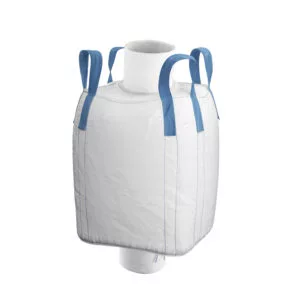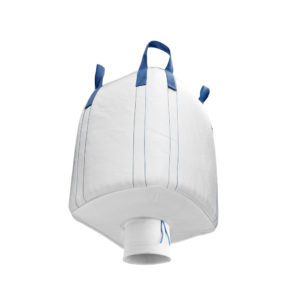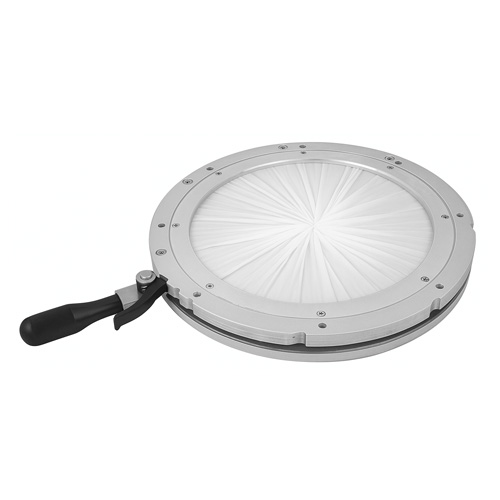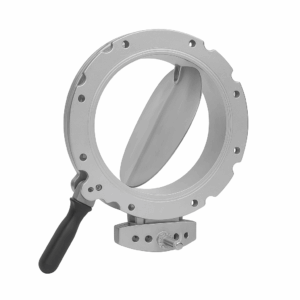Jumbo & Bulk Bag Valves: Your Ultimate Guide

Traditional methods for the transportation and storage of bulk materials often involve manual handling, which is time-consuming, labor-intensive, and prone to errors. Moreover, preventing material spillage and ensuring proper containment are constant concerns.
These inefficiencies not only impede productivity but also contribute to increased costs and safety risks, making the seeking innovative solutions to streamline their operations, improve efficiency, and enhance safety standards.
Enter the bulk bag valve; a versatile solution that addresses these concerns head-on.
So, What is a Bulk Bag Valve and How Does it Work?
A bulk bag valve is a specialized component designed to facilitate the discharge of bulk materials from large bags, commonly known as bulk bags or big bags.
The valve consists of a flexible tube or spout that can be opened or closed to control material discharge. It’s typically attached to the bag through a valve body or ring, which provides a secure connection.
Operating the valve is as simple as:
- Opening: Simply lift or slide the tube or spout to an open position. This creates a clear path for the materials to flow out of the bag.
- Closing: Lowering or positioning the tube or spout to a closed position, effectively sealing off the flow of materials.
Types of Bulk Bag Valves
Bulk bag valves come in various designs and configurations to suit different material handling requirements, with the most common being:
- Spout top valves
- Spout bottom valves
- Iris valves
- Butterfly valves
- Cone valve systems
Let’s briefly look at each of these in turn so you’re fully armed with all the options to suit your requirements:
Spout Top Valves

In terms of industries, they’re ideal for ones that require precise control over the material loading. The operator can regulate the flow by adjusting the size of the spout opening, enabling accurate filling of downstream equipment or containers, minimizing waste and ensuring efficient material transfer.
As such, food processing, pharmaceuticals, and chemical manufacturing industries benefit from spout top valves due to their ease of use, effective containment, and ability to handle various materials. This simplicity and versatility makes them suitable for powders, granules, and small particles.
Spout Bottom Valves

When the valve is opened, the force of gravity ensures that the material flows smoothly and consistently without the need for excessive manual intervention.
They’re particularly beneficial in applications where complete emptying of the bag is required, such as in the pharmaceutical, chemical, or food industries since they allow for efficient and clean bulk bag discharge, leaving minimal residue or waste in the bag.
Their design also enables easy connection to downstream equipment, such as hoppers or conveyors, facilitating seamless material transfer. This integration enhances process efficiency, minimizes manual handling, and reduces the risk of contamination or material spillage during transfer.
To combine the power of spout top and bottom valves with our spout top and bottom bulk bags, check out our full range of options below!
Iris Valves
Iris valves, also known as slide-gate valves, are a type of bulk bag valve that feature a circular or oval-shaped opening controlled by a sliding gate mechanism.
This design allows for precise regulation of the material flow by adjusting the gate position, which is adjustable to create a tight seal, preventing material leakage or spillage during transportation or storage.
They also offer excellent flexibility and adaptability for a wide range of materials, such as:
- Powders
- Granules
- Cohesive or fibrous substances.
Industries that handle materials requiring accurate dosing or batching often choose iris valves due to their ability to provide controlled discharge rates. Examples of such industries include pharmaceutical manufacturing, chemical processing, and construction materials production.
The versatility of iris valves extends to their compatibility with different bag sizes and configurations. They can be easily adapted to fit bags of varying diameters, making them a versatile solution for companies that work with different bulk bag specifications.
Butterfly Valves
Butterfly valves feature a disc-shaped closure mechanism; the disc rotates around a central axis to control the material flow. When fully open, the disc allows for unobstructed discharge, while closing the disc restricts or stops the flow.
They provide excellent flow control and are often utilized in industries that require precise metering or batching of materials and where bulk materials need to be transferred or distributed accurately, such as:
- Agriculture
- Mining
- Food processing
Furthermore, the simple and efficient design of butterfly valves allows for quick and easy operation, making them suitable for high-throughput applications.
Finally, their compact size and minimal maintenance requirements contribute to their popularity. They can be integrated into existing material handling systems without extensive modifications and are known for their durability and reliability.
Cone Valve Systems
Cone valve systems are a specialized type of bulk bag valve that utilizes a cone-shaped internal valve mechanism. The cone valve is positioned at the bottom of the bag, and as it rotates, it opens or closes the discharge opening, allowing for controlled material flow.
They provide excellent flow control, even for challenging materials such as cohesive or difficult-to-handle powders. The rotating action of the cone valve breaks up material bridges and ensures consistent discharge, preventing clogs and blockages.
Additionally, they’re known to handle high-pressure or dense materials well. The cone valve creates a tight seal when closed, allowing the bag to be pressurized and ensuring complete discharge of the contents.
They’re commonly used in industries that handle materials with poor flow characteristics, such as chemicals, minerals, and abrasive substances. They’re also suitable for applications that require precise dosing or blending, making them popular in the pharmaceutical and food processing sectors.
Note that their robust construction ensures durability and longevity, even in demanding operating conditions. The self-cleaning nature of the rotating cone valve minimizes maintenance requirements and contributes to uninterrupted material flow.
Why are Bulk Bag Valves Important in the Industrial Sector?
Bulk bag valves offer a multitude of advantages that greatly improve efficiency and safety in material handling, such as:
- Improved material containment
- Reduced material spillage and waste
- Enhanced efficiency and time savings
- Minimized manual handling and labor costs
- Increased safety and environmental compliance
Improved Material Containment
The valves are designed to securely seal the bulk bags, preventing any leakage or spillage during transportation, storage, or discharge.
Also, the airtight seal created by the valves ensures that the contents of the bulk bags remain intact and protected from external factors such as moisture, dust, or contaminants. This improved material containment not only preserves the quality and integrity of the materials but also minimizes the risk of cross-contamination.
Furthermore, bulk bag valves often incorporate features such as gaskets or seals, which provide an additional layer of protection against leaks. By effectively containing the materials, bulk bag valves offer peace of mind to industries that handle hazardous or sensitive substances.
Whether it’s chemicals, pharmaceuticals, or food products, the improved material containment provided by bulk bag valves ensures that valuable resources aren’t wasted and that stringent quality control measures are met.
This is especially the case when using UN bulk bags, which are specifically designed for handling hazardous materials.
Reduced Material Spillage and Waste

By incorporating features like adjustable flow rates and opening/closing mechanisms, bulk bag valves allow operators to regulate the material discharge with accuracy. This minimizes the chances of overflows, spills, or accidental releases.
As a result, industries can experience substantial cost savings by reducing material waste and increasing overall efficiency. Moreover, the reduced material spillage contributes to a cleaner and safer working environment, reducing slip and fall hazards and potential environmental contamination.
Enhanced Efficiency and Time Savings
With traditional methods, such as manually scooping or transferring materials, the process is time-consuming and labor-intensive. In contrast, bulk bag valves enable quick and controlled discharge of materials, allowing for faster turnaround times.
The adjustable flow rates and opening/closing mechanisms of bulk bag valves offer precise control over the material flow. This enables operators to discharge the desired amount of material at the required rate, eliminating the need for manual adjustments or repetitive actions.
Additionally, bulk bag valves can be integrated with automated systems, further optimizing efficiency and reducing dependency on manual labor.
Minimized Manual Handling and Labor Costs
Manual handling of heavy and bulky bags can pose risks of injuries, strains, or accidents for workers. By utilizing bulk bag valves, the need for manual scooping, pouring, or lifting is eliminated.
Bulk bag valves enable direct connection between the bulk bag and the downstream equipment or storage vessel, facilitating seamless material transfer.
Operators can simply attach the valve, initiate the discharge, and oversee the process without the need for extensive physical effort. This not only ensures a safer working environment but also reduces labor costs associated with manual handling.
By leveraging the efficiency of bulk bag valves, companies can optimize their workforce allocation, allocate resources to more value-added tasks, and reduce the risk of workplace injuries, ultimately leading to improved employee morale and reduced insurance claims.
Increased Safety and Environmental Compliance
The airtight seal provided by these valves prevents the release of hazardous or harmful substances during transportation or discharge. This minimizes the risk of exposure to personnel and the surrounding environment.
In industries such as chemicals, pharmaceuticals, or mining, where handling hazardous materials is common, the implementation of bulk bag valves ensures compliance with stringent safety regulations.
This is due to their containment measures reducing the risk of spills, leaks, or emissions, mitigating potential hazards and ensuring the protection of employees, the public, and the ecosystem.
Moreover, bulk bag valves contribute to environmental sustainability by reducing material waste, preventing pollution, and minimizing the carbon footprint associated with inefficient material handling practices.
Common Issues and Troubleshooting Tips for Bulk Bag Valves
While bulk bag valves are designed to be reliable and efficient, there are certain downsides you should be aware of, namely:
- Initial investment and installation costs
- Learning curve and training requirements
- Maintenance and repair considerations
- Limited compatibility with certain materials
Initial Investment and Installation Costs
Compared to traditional manual handling methods, the upfront cost of acquiring bulk bag valves and integrating them into existing systems can be significant. The cost will depend on factors such as the type of valve, the desired features, and the complexity of the installation.
However, it’s essential to consider this as a long-term investment. The efficiency gains, labor savings, and material conservation provided by bulk bag valves can outweigh the initial expenses over time.
Learning Curve and Training Requirements
Training programs and instructional materials provided by valve manufacturers can help bridge the knowledge gap and expedite the learning process, but this comes with a learning curve.
It’s important to allocate sufficient time and resources for training to ensure that operators understand the nuances of the valves, including adjusting flow rates, opening and closing mechanisms, and troubleshooting common issues.
By investing in comprehensive training, businesses can maximize the benefits of bulk bag valves and ensure that their employees have the necessary skills to operate the equipment safely and effectively.
Over time, as operators become proficient in using bulk bag valves, the learning curve becomes less significant, and the overall efficiency of material handling processes increases.
Maintenance and Repair Considerations

Like any mechanical equipment, bulk bag valves require regular maintenance to ensure their optimal performance and longevity.
Maintenance tasks may include inspections, cleaning, lubrication, and checking for wear and tear. The frequency and intensity of maintenance will depend on factors such as the type of valve, the operating conditions, and the materials being handled.
In the event of a valve malfunction or damage, timely repairs are essential to minimize downtime and maintain operational efficiency. Having a spare valve or readily available replacement parts can help expedite the repair process.
Limited Compatibility with Certain Materials
While bulk bag valves are suitable for a wide range of materials, certain substances may not be compatible with specific valve designs.
For example, some materials may have unique characteristics, such as high temperatures, corrosive properties, or abrasive nature, which can impact the valve’s performance or longevity.
Valve manufacturers will provide guidance on selecting the appropriate valve materials, coatings, or additional protective measures to ensure compatibility and avoid potential issues.
In cases where materials are highly abrasive or prone to causing excessive wear, it may be necessary to consider alternative solutions, such as using specialized valves or incorporating additional equipment, such as filters or screens, to protect the valve from damage.
How to Choose the Right Bulk Bag Valve for Your Needs?
Choosing the right bulk bag valve involves considering several factors that are specific to your application. Here are some important things to keep in mind:
- Material type: Different materials have different flow characteristics. Factors such as particle size, moisture content, and abrasiveness should be taken into account.
- Required flow rate and pressure: This information helps determine the appropriate valve size, diameter, and design that can handle the required capacity without any issues.
- Additional features and options: Integrated dust control systems, level indicators, and safety mechanisms enhance overall productivity, safety, and ease of operation.
Valves Integrate with Palmetto Industries’ Bulk Bags
Whether you require precise flow control, complete material discharge, or compatibility with challenging substances, our bulk bags integrate exceptionally well with bulk bag valves.
Get in touch with us to discover how Palmetto Industries can help you achieve unmatched productivity, reduced costs, and unparalleled quality control.
Final comments
There’s no doubt that bulk bag valves provide an efficient and reliable solution to the challenges faced by industries dealing with bulk materials.
By implementing the appropriate type of bulk bag valve, businesses can streamline their operations, reduce costs, enhance safety standards, and achieve greater productivity.
Understanding the various types, industries that benefit, as well as the pros and cons, will empower you to make informed decisions when incorporating bulk bag valves into your material handling processes.








